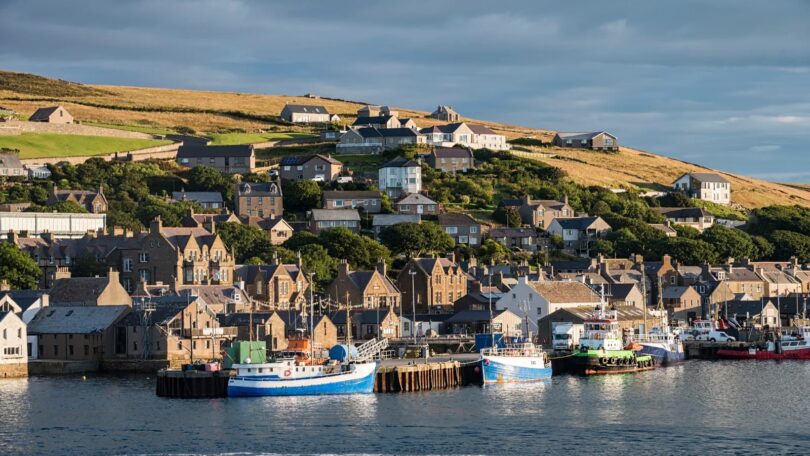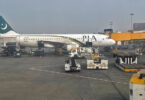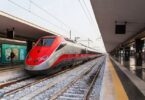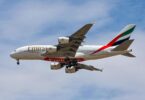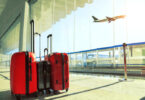Karen Gardiner
The massive red sandstone St Magnus Cathedral looms over Kirkwall, the capital of the Orkney Islands. Inside lie the bones of Magnus Erlendsson, the Viking Earl of Orkney who, in the early 12th Century, was murdered on the island of Egilsay on the orders of his cousin, a rival chieftain named Haakon.
It’s a reminder of the drama and power struggles of these islands’ Viking history. Not that you’d need one: Orkney’s Norse story, though long in the past, has a habit of resonating through the ages, resurfacing in contemporary popular culture, like the 2022 film The Northman and in modern politics.
Orkney made headlines worldwide this week with news that the archipelago wants to leave both Scotland and the UK in order to join, or rather rejoin, Norway. The details of this modern saga are, however, a little more nuanced than many of those headlines suggested. Orkney Islands Council leader, James Stockan, argued that Orkney receives insufficient funding and attention from both the UK and Scottish governments, and proposed that the islands look at options offering greater autonomy, such as changing their status in the UK and becoming a crown dependency like Jersey and Guernsey; or becoming a self-governing territory of Norway, similar to the Faroe Islands, which is a self-governing Danish territory. On Tuesday, councillors voted 15 to 6 in favour of exploring such alternative methods of governance, potentially opening the doors to a new future for the islands.
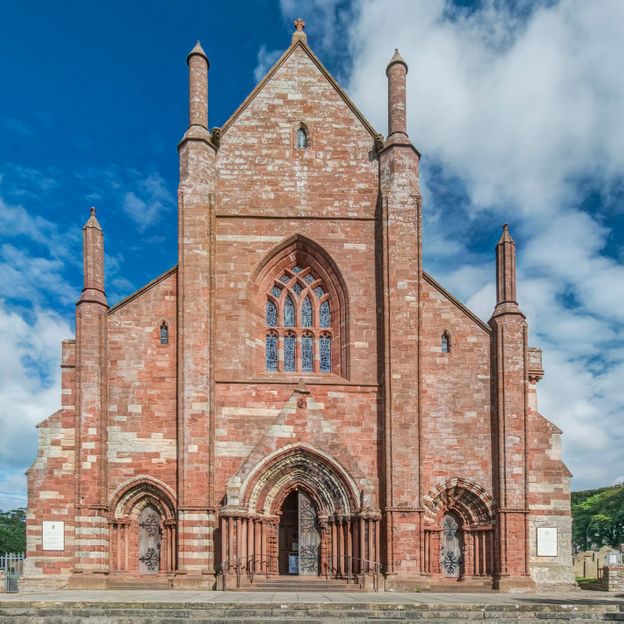
St Magnus Cathedral in Kirkwall houses the the bones of a Viking earl (Credit: Mint Images/Getty Images)
The idea of Orkney becoming a self-governing Norwegian territory may be, in the words of councillor David Dawson, mere “fantasy”, but the story has focused attention on the rich Norse heritage of the islands, which, along with the Shetland Islands, were under Norwegian and Danish control until the mid-15th Century. In 1468, Princess Margaret of Denmark married James III of Scotland, but Margaret’s father, Christian I, couldn’t afford a dowry, so he mortgaged Orkney and then Shetland. By 1472, the debt was still unpaid so the islands came under Scottish control.
“We were part of the Norse kingdom for much longer than we were part of the United Kingdom,” Stockan told BBC News (Scotland joined England in 1707 in a union that later became the United Kingdom). “On the street in Orkney, people come up and say to me when are we going to pay back the dowry, when are we going back to Norway? There is a huge affinity and a huge deep cultural relationship there.”
We were part of the Norse kingdom for much longer than we were part of the United Kingdom
Orkney, an archipelago of 70 islands off the northern tip of mainland Scotland, is believed to have been inhabited for around 8,500 years. Visitors can sense that long, deep history at some of the oldest and best-preserved Neolithic sites in Europe, including the stone circle Ring of Brodgar, the 5,000-year-old village Skara Brae and the chambered cairn of Maeshowe, which is etched with graffitied runes carved by Vikings. But it is the Norse era – the period from when Vikings arrived until the end of the Earldom of Orkney – though relatively short, that dominates Orcadian culture and history.
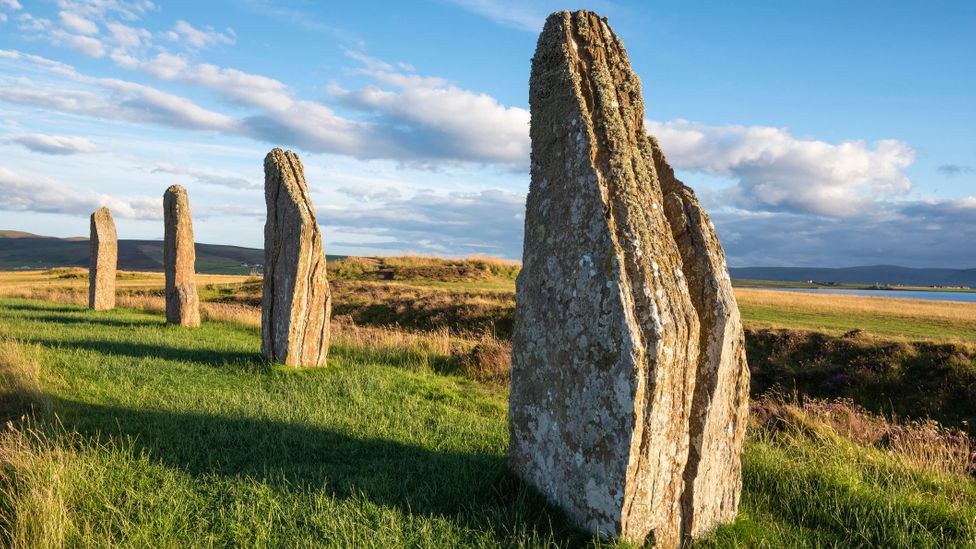
The Ring of Brodgar is an iconic symbol of Orkney’s prehistoric past (Credit: Westend 61/Getty Images)
Vikings started arriving in Orkney from Norway in the late 8th Century and found the fertile islands so much to their liking that they stayed for 500 years, settling as farmers and using the islands as a base to launch further voyages. The story of Orkney’s Viking era is colourfully told in the Orkneyinga Saga, written by an unnamed Icelandic author in the late 12th Century, but for some Orcadians – around 30% of whom have Scandinavian ancestry – it is not consigned to the past.
“Most of what we have here is Viking,” local entrepreneur Stephen Kemp told me from his home in Kirkwall. The name Kirkwall, he explained, comes from the Old Norse word Kirkjuvágr, meaning “Church Bay”. Kemp says that he has always been surrounded by Orkney’s Norse heritage, from the names of his school classmates (Erik, Einar) to the archipelago itself –”Orkney” is derived from Orkneyjar, meaning “seal islands” in Old Norse.
When setting up his business, Orkney Distilling Company, Kemp wanted to pay tribute to this heritage, and so creates gins with names such as Kirkjuvagr, made with ingredients including angelica and bere barley, both brought to the islands by Vikings.
Orkney folk are different. We’re outward looking and that comes from being islanders
While he holds his Norse heritage close, Kemp considers the Norway proposal a non-starter, or a “bit of a red herring”. But, he says, “it’s grabbed headlines, which is good.” Pointing to the neglect of Orkney’s aging fleet of inter-island ferries and a controversial and now-scrapped proposal by the Scottish government to create Highly Protected Marine Areas in 10% of Scotland’s seas, which would have restricted fishing, a lifeblood for many Orcadian communities, Kemp said, “it’s driven by years of frustration at not being listened to” by Holyrood [the home of the Scottish Parliament] and Westminster.”
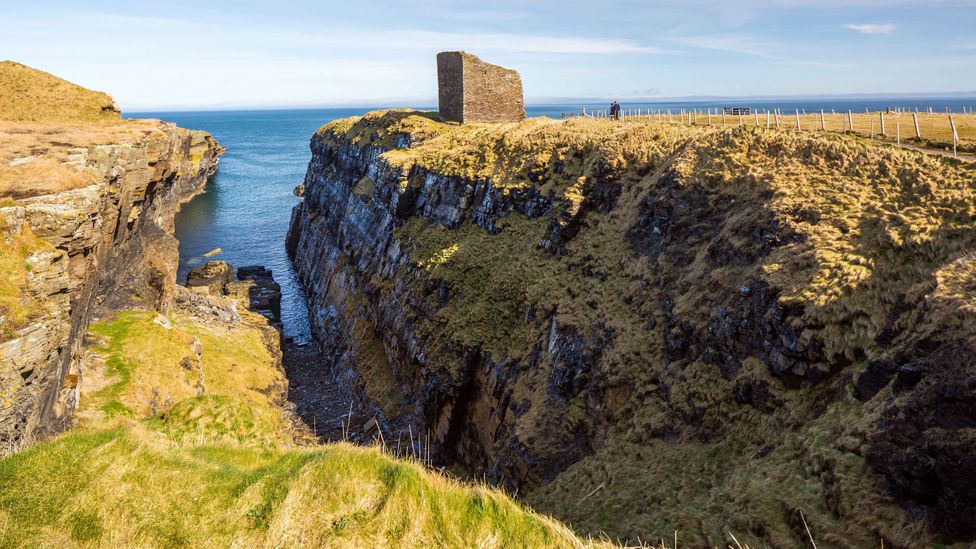
The ruins of the Viking-built Castle of Old Wick can be seen in Caithness in north-east Scotland (Credit: Sebastian Wasek/Alamy)
“I’m confident there’s some mileage in self-determination,” he said, and that is largely due to the independent spirit of Orcadians. “Orkney folk are different,” he added, “we’re outward looking and that comes from being islanders.” Like their seafaring forebears, they are always looking towards what lies beyond the horizon. “It makes us entrepreneurial and innovative. We’re prepared to do things differently.”
Viking colonisers left their mark all over Scotland, from Largs in the south-west (home to Vikingar, which tells the story of Scotland’s Viking age, and an annual Viking festival), to Wick in the north-east, where the ruins of the Viking-built Castle of Old Wick still stand. Scotland as a whole has at times drawn on its cultural and geographical proximity to the Nordic countries to distinguish itself from the rest of the UK –particularly during the run up to the 2014 independence referendum, when the Scottish government explored making closer ties with the Nordic countries rather than the UK. But nowhere in Scotland wears its Norse heritage quite as proudly as the Northern Isles of Shetland and Orkney.
VIDEO: Why the Vikings never left Scotland
Travellers encounter Orkney’s Norse heritage from the moment they arrive, whether by air – Kirkwall Airport’s sign is written in runes – or by sea, where NorthLink ferries are emblazoned with giant images of bearded, horn-helmeted Vikings. Throughout the islands, you’re also more likely to see the Nordic Cross-style Flag of Orkney flown than the Scottish saltire. If you happen to be visiting on 17 May, you’ll see Norwegian flags too, when Kirkwall celebrates Norway’s national day with a procession through town. You can also follow a 55-mile walking route, the St Magnus Way, that takes in many of Viking sites including the remains of a Norse village at Brough of Birsay.
But Orkney’s Norse heritage runs deeper than visual symbols. It is a cornerstone of the islands’ language, folklore and traditions, according to Professor Donna Heddle, director of the University of the Highlands and Islands’ Institute for Northern Studies. “Modern Orcadian is derived from a language called Norn which was spoken in the Northern Isles until the 18th Century [and was] very like modern Icelandic or Faroese,” she said. Heddle also points out that trows, supernatural beings of Orcadian folklore, “are very similar to Norwegian trolls, [and] our boat-building techniques are influenced by Norse styles – the Orkney yole is the direct descendant of the Viking longboat.”
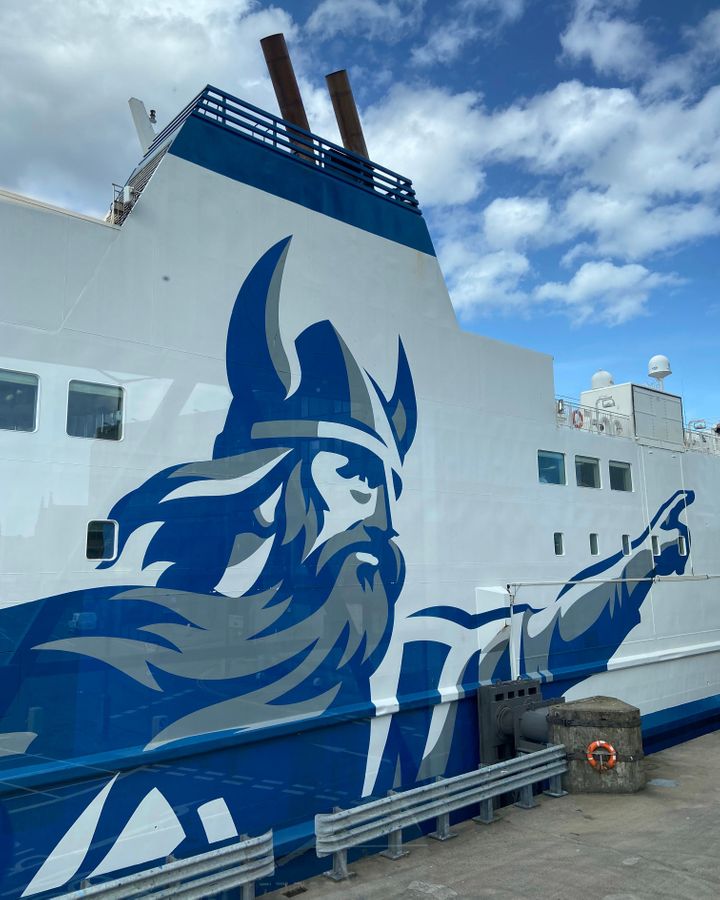
Travellers will be reminded of the islands’ Viking past on the islands’ NorthLink ferries (Credit: Karen Gardiner)
When it comes to politics, Heddle sees Orkney’s “socially democratic and community-based” attitude chiming with that of the rest of Scotland (which typically leans left), but attributes Orkney’s “independent and resilient spirit” to both its Norse heritage and island status.
From the vantage point of London or Edinburgh, these islands, hanging off the far north-eastern corner of the map of Britain, may appear remote. But their strategic location, where the North Sea meets the North Atlantic Ocean, has put them on the world’s stage, from Viking sagas to both World Wars. If there is a sense of remoteness in Orkney, it is from the seats of power in London and Edinburgh. All the better, then, to forge a path towards self-determination, which the islands have been pursuing, with less fanfare, for years. Along with Shetland and the Western Isles, Heddle points out, Orkney led the 2014 Our Islands, Our Future campaign, which led to the appointment of an Islands Minster in the Scottish parliament, and the now-implemented Islands Act and Island Plan which aim to empower island communities by strengthening their voices within Scotland, support sustainable growth and reverse depopulation.
Orcadians’ Norse ancestors were renowned for their courage, action and independent spirit. Much of that resourceful attitude runs through Orkney today: “We’re often overlooked,” said Kemp, “[so] we have to fight for what we get.”
Courtesy: BBC

